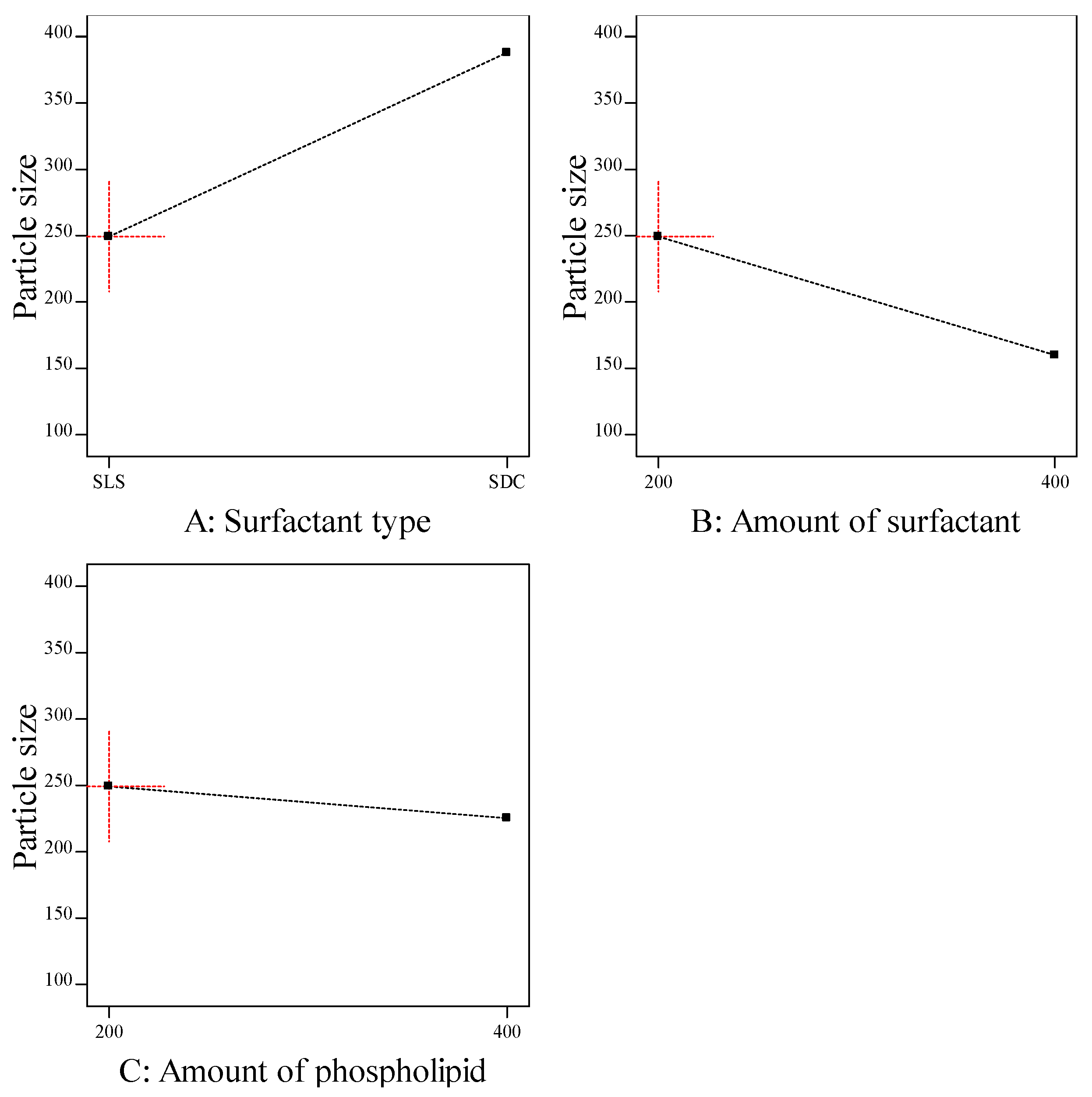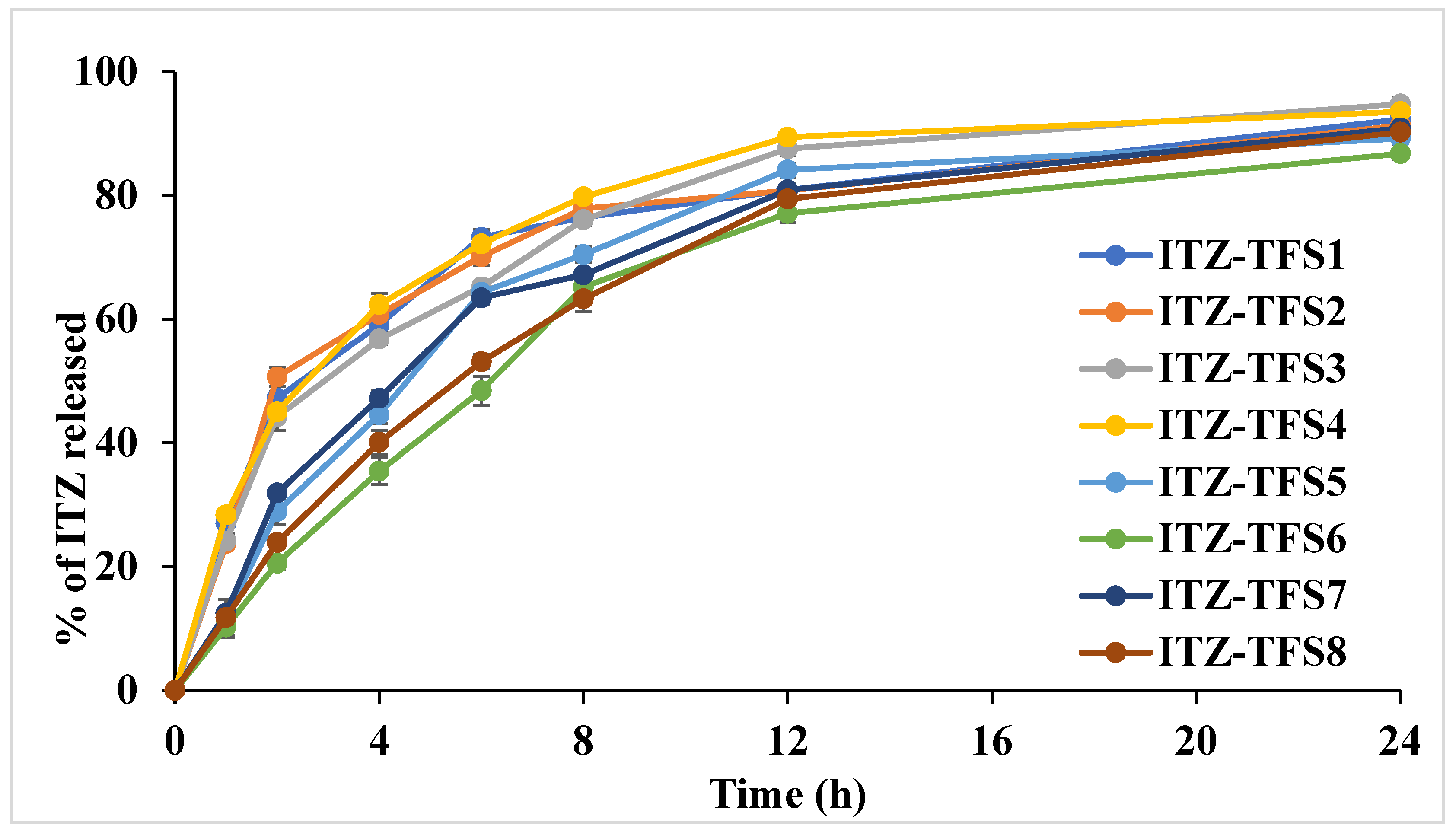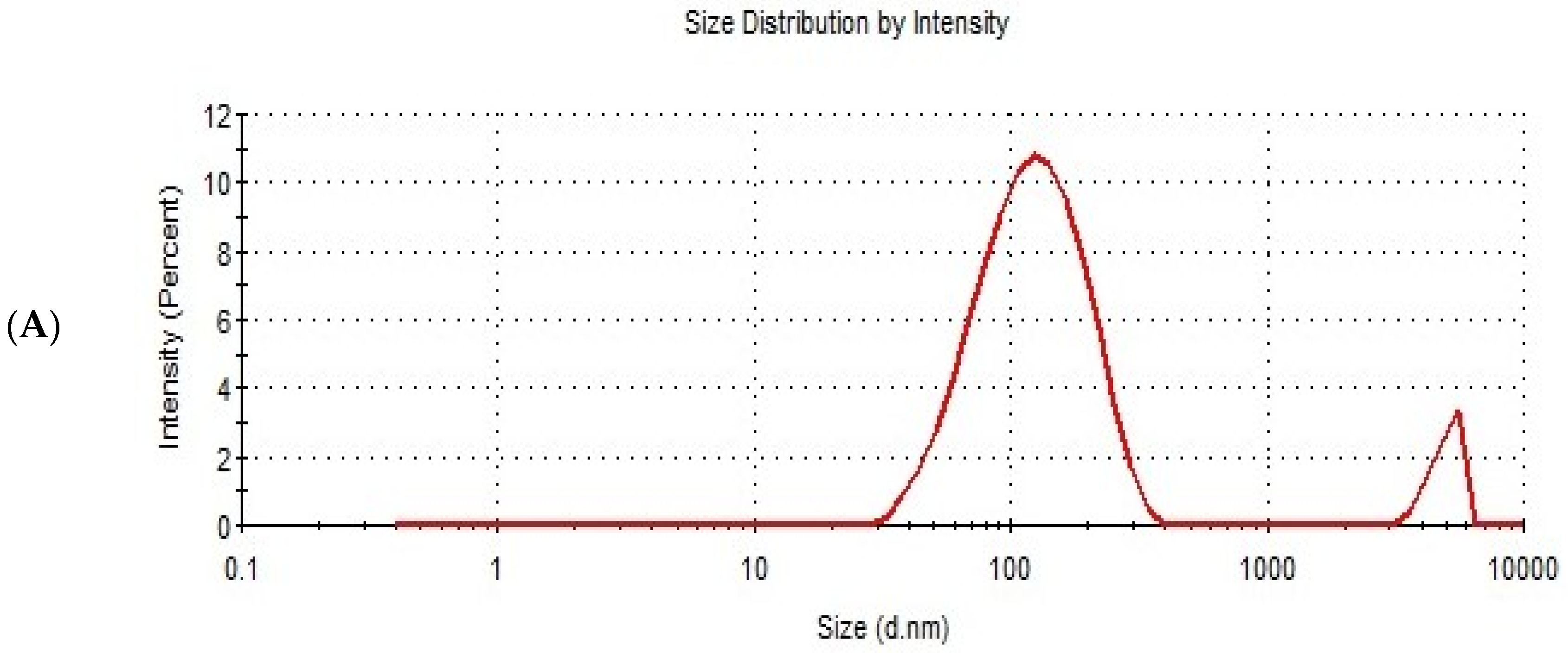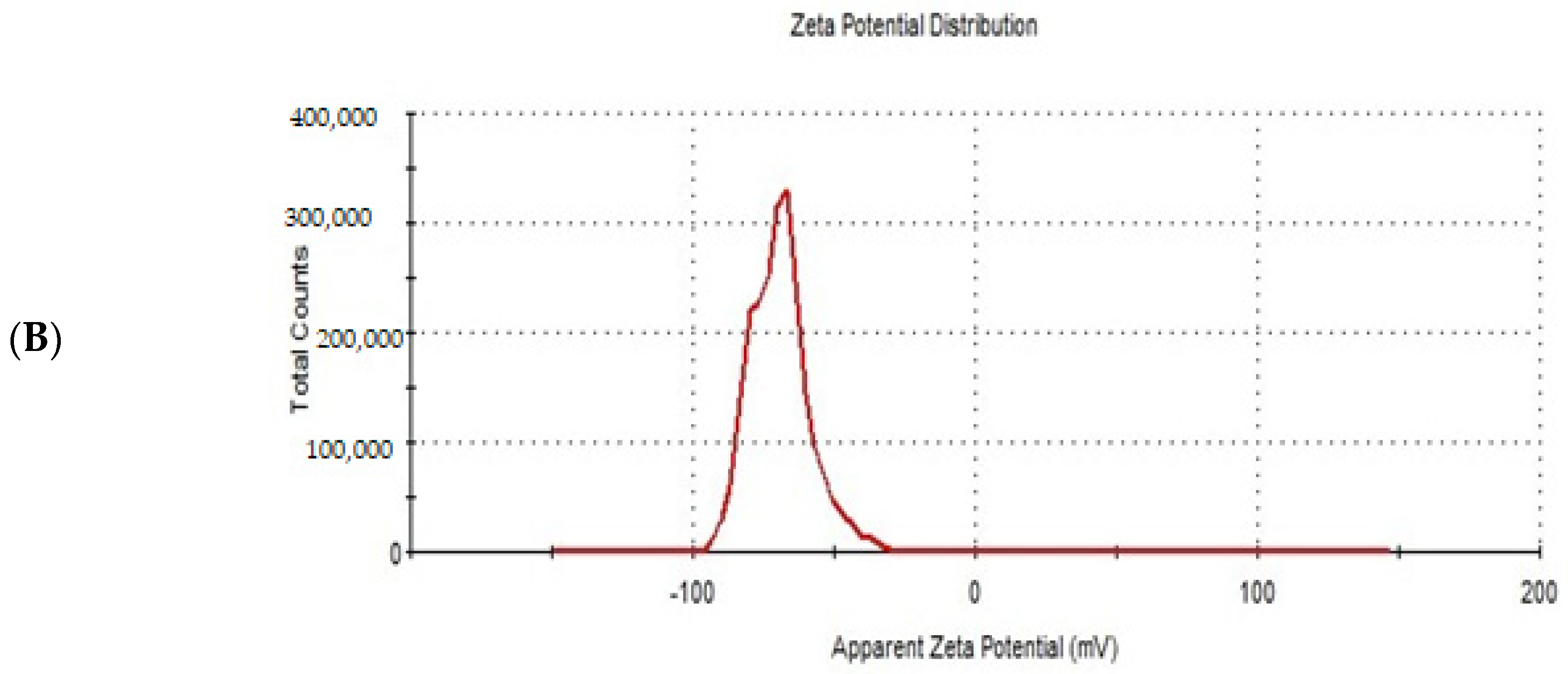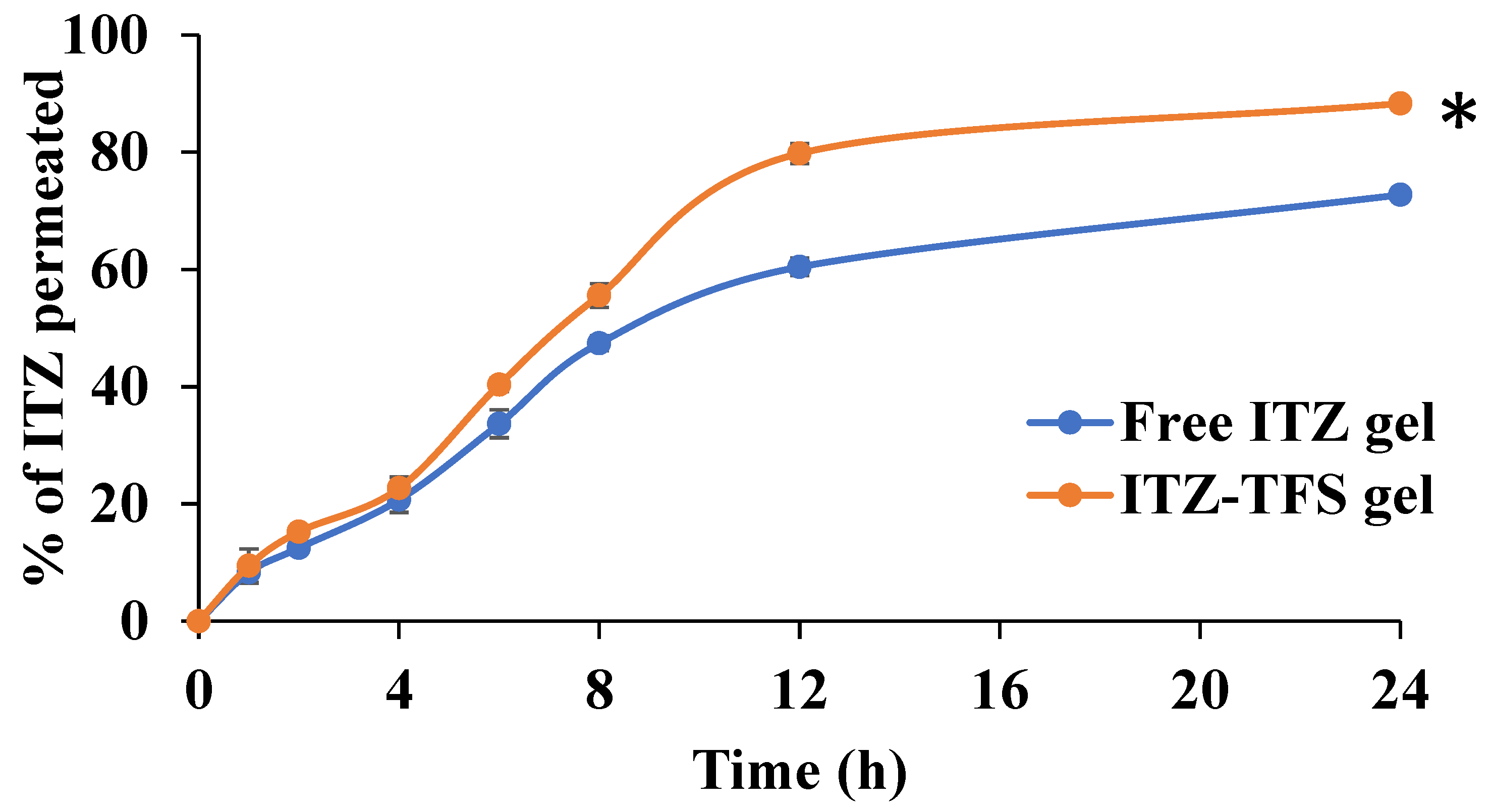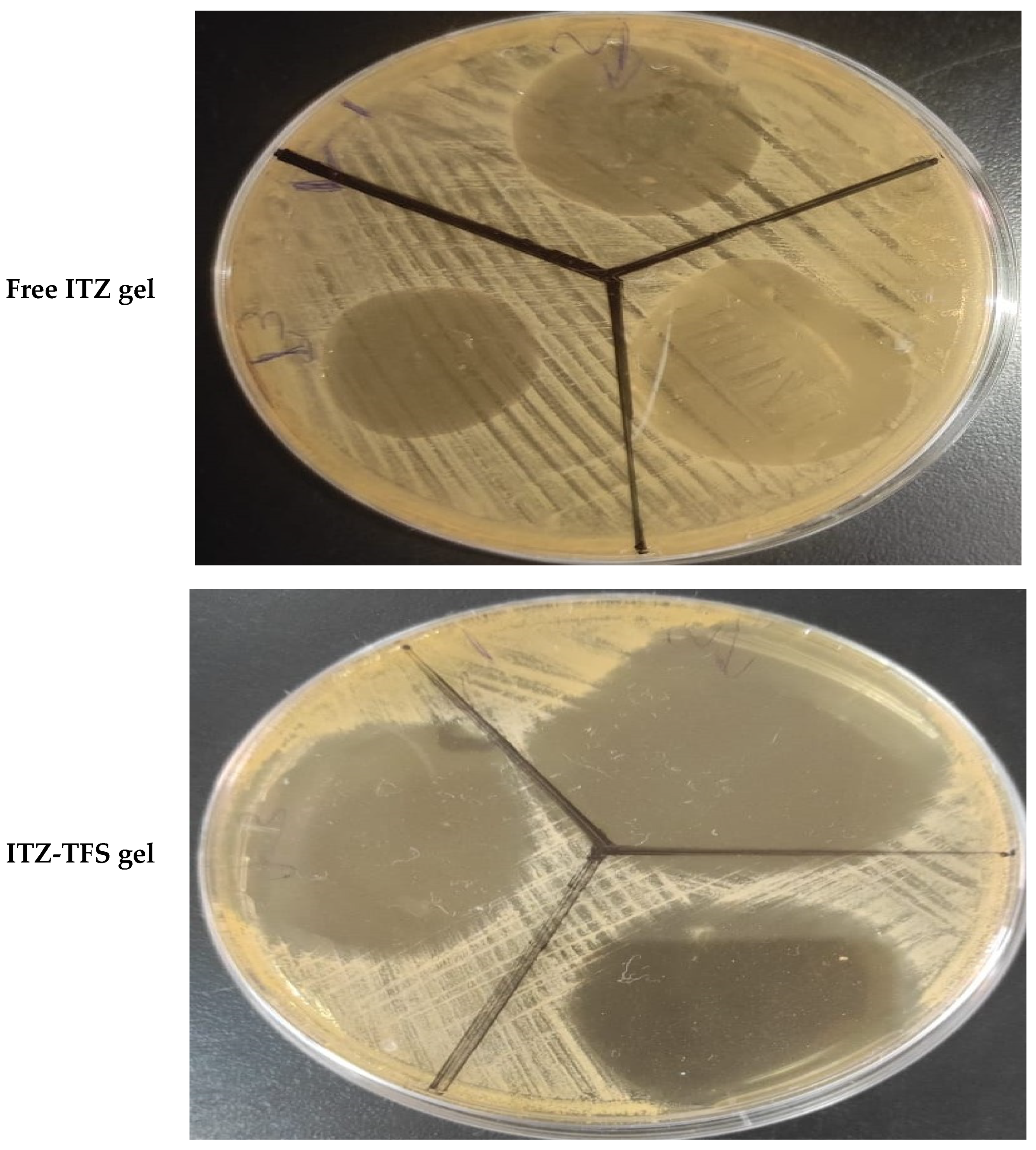1. Introduction
Superficial mycosis is a fungal disease that often affects the top layers of the skin, nails, and hair but can also spread to deeper tissues. Numerous microorganisms, including bacteria and fungi, commonly inhabit the human skin (normal flora) [
1]. Overgrowth of any of these members of normal flora can occur as a result of many potential underlying medical conditions.
Candida albicans is a yeast that typically lives on the skin folds such as the armpits, digestive tract, mouth, and vagina [
2]. Skin infection by
Candida albicans (candidiasis) can cause intense itching and redness [
3]. The main causes of candidiasis are warm weather, tight clothing, poor hygiene, obesity, the use of antibiotics, the use of corticosteroids, and the suppressed immune system [
4].
Itraconazole (ITZ) is a triazole antifungal agent that has broad-spectrum activity [
5]. It works by inhibiting ergosterol synthesis by interacting with the fungal 14 alpha-demethylase substrate-binding sites, thus inhibiting the conversion of lanosterol to ergosterol [
6]. This impaired ergosterol synthesis leads to deformity of the fungal membrane that enhances permeability and disrupts the integrity of the fungal cell membrane, and membrane-bound enzyme activity is changed [
7]. ITZ belongs to a BCS class II which is characterized by low water solubility. It has an extremely low aqueous solubility of approximately 1 ng/mL at neutral pH and 5 µg/mL at pH 1 [
8,
9].
Oral preparations of ITZ including solutions and capsules as well as intravenous preparations are well-known and widely used in medicine. Recently, due to toxicity concerns associated with systemic use, ITZ is increasingly being investigated for its topical antifungal activities and many reports proved it can be successfully delivered via this route [
10,
11].
Conventional topical preparations such as lotions, gels, ointments, and creams are facing several challenging factors affecting the drug delivery process [
12]. These factors include low lipid solubility, the high molecular weight of the drug, and the barrier properties of the skin [
13]. The stratum corneum is the outer shell of the epidermis which acts as a barrier preventing the penetration of topically applied antifungal drugs [
14]. The skin permeability can be enhanced by either modifying the drug formulation or skin permeation enhancers [
15]. Nanotechnology-based drug delivery systems offer effective drug delivery to overcome these problems [
16]. Nanotechnology is a collection of techniques including the design, synthesis, characterization, and application of structures, materials, devices, and systems by controlling the size and shape on the nanoscale, which is capable of overcoming various challenges in drug delivery [
17]. Transferosomes (TFS) are highly flexible, deformed vesicles with an aqueous core surrounded by a lipid bilayer which enables them to be a good carrier for both hydrophilic and hydrophobic drugs [
18]. Several studies used nanotechnology for improving the skin permeability of ITZ. Alomrani et al. developed ITZ niosomes using different nonionic surfactants, (tween, span, and Birj) to enhance its antifungal activity [
19]. Passos et al. prepared ITZ-loaded nanostructured lipid carriers to improve its skin permeability and increase its localization in skin lesions associated with fungal infections [
20]. Hashem et al. prepared ITZ-loaded ufasomes to enhance the skin permeability and improve its antifungal activity against
Candida albicans [
21].
The aim of this work was the preparation of ITZ-TFS to enhance its antifungal activity against Candida albicans, using different surfactants (sodium deoxycholate (SDC) and sodium lauryl sulfate (SLS)), different surfactant amounts (200 and 400 mg), and different phospholipid amounts (200 and 400 mg). Eight formulations were prepared by thin lipid film hydration technique. The prepared formulations were examined for the entrapment efficiency % (EE%), particle size, zeta potential, polydispersity index (PDI), and in vitro permeation. The best formulation was incorporated in Hydroxypropyl Methylcellulose (HPMC) gel base and evaluated for spreadability, pH, drug content, and in vitro antifungal activity, in comparison with HPMC gel base loaded with free ITZ.
2. Materials and Methods
2.1. Materials
Itraconazole (ITZ) was purchased from Sigma-Aldrich (St. Louis, MO, USA). Phospholipid 90 H was kindly donated by Lipoid GmbH (Ludwigshafen, Germany). Sodium deoxycholate (SDC) and sodium lauryl sulfate (SLS) were purchased from Loba Chemie (Mumbai, India). Hydroxyl propyl methyl cellulose (HPMC) was purchased from Alpha Chemica (Mumbai, India). All other chemicals were of analytical grade.
2.2. Design of ITZ-TFS Formulations Using 2^3 Full Factorial Design
Design Expert software is designed to help with the design and interpretation of multi-factor experiments [
22]. It offers a wide range of analytical and graphical techniques for model fitting and interpretation. A 2^3 full factorial design is a type of experimental design that designs 8 formulations and allows researchers to understand the effects of three independent variables (each of 2 levels) on the dependent variable.
In this study, design expert version 11 (Stat-Ease, Inc., Minneapolis, MN, USA) was used to obtain the composition of ITZ-TFS formulations. The independent variables were type of surfactant (X1), amount of surfactant (X2), and amount of phospholipid (X3) while the dependent variables were the entrapment efficiency % (Y1), particle size (Y2), and zeta potential (Y3).
The type of surfactant (X1) was used in two levels (SLS and SDC), the amount of surfactant (X2) was used in two levels (200 and 400 mg), and the amount of phospholipid was used in two levels (200 and 400 mg). The independent and dependent variables of ITZ-TFS formulations are represented in
Table 1.
2.3. Preparations of ITZ-TFS Formulations Using Thin Lipid Film Hydration Technique
In a dry, round-bottom flask, accurate amounts of phospholipid, surfactant, and drug were dissolved in a mixture of organic solvents (10 mL) consisting of chloroform and methanol (1:1,
v/
v). To prepare a thin lipid film on the wall of the round-bottom flask, the organic solvent was allowed to evaporate using a Heidolph rotavap (P/N Hei-AP Precision ML/G3, Schwabach, Germany) set to 60 rpm at 45 °C under low pressure [
23]. The dry thin lipid film was hydrated with 10 mL of distilled water by rotating it at 60 rpm for 1 h at room temperature. The formed lipid vesicles were allowed to swell at room temperature for 2 h [
24]. The transferosomal dispersions were then collected and sonicated, in a water bath sonicator, for 2 min then kept in a refrigerator at 4 °C overnight to complete maturation for further investigation.
2.4. Determination of the Entrapment Efficiency % (EE%) of ITZ-TFS Formulations
The centrifugation method was used to determine the EE% of ITZ in the prepared ITZ-TFSs. To separate the entrapped ITZ from the unentrapped medication, 2 mL of each formulation was centrifuged at 14,000 rpm for 45 min in a cooling centrifuge (Biofuge, primo Heraeus, Germany) [
25]. Using a UV spectrophotometer (Shimadzu, Kyoto, Japan), the supernatant was examined spectrophotometrically for the presence of un-entrapped ITZ at 262 nm after dilution to 100 mL with phosphate buffer saline (pH 7.4). The following equation was used to compute the EE%:
2.5. Measurement of the Particle Size, Zeta Potential, and Polydispersity Index (PDI) of ITZ-TFS Formulations
Particle size, zeta potential, and polydispersity index were measured for the ITZ-TFS formulations that were prepared. Zeta potential is the value of charge in the boundary between the nanoparticle and the dispersion medium, the higher the value of zeta potential, the higher the physical stability of the dispersion. PDI is a value, which indicates the homogeneity or heterogeneity of particle size. Each ITZ-TFS sample was diluted to 1% concentration before being evaluated by Zetasizer (Malvern Instruments Ltd., Malvern, UK) at 25 °C. The measurement was done at a 90° angle using the dynamic light scattering technique [
26].
2.6. In Vitro Drug Release of ITZ-TFS Formulations
The ITZ-TFS formulations’ in vitro release study was conducted utilizing Franz’s diffusion cell apparatus (Maharashtra, Mumbai, India). The donor compartment was filled with 2 mL of each ITS-TFS formulation, and the receptor compartment was filled with 12 mL of phosphate buffer saline (pH 7.4). Throughout the experiment, the dissolving medium was stirred at 100 rpm and maintained at 37 ± 1 °C [
15]. The donor and receptor chambers were separated by a cellophane membrane (1.7 cm diameter). At predetermined intervals, 1 mL samples were obtained (1, 2, 4, 6, 8, 12, and 24 h). After the necessary dilutions, all samples were subjected to spectrophotometric examination using a UV spectrophotometer at 262 nm. The experiment was conducted in triplicate, and the mean ± SD was computed.
2.7. Selection of the Optimized Formulation of ITZ-TFS
The best ITZ-TFS was selected to complete further studies. The best formulation was selected based on the highest EE%, smallest particle size, and highest zeta potential. The optimization process was done using Design Expert software version 11 (accessed on 7 February 2023) to obtain the optimized formulae with the optimum responses.
2.8. Transmission Electron Microscopy (TEM) Image of the Optimized ITZ-TFS
A transmission electron microscope (TEM), (JEOL
®, Tokyo, Japan) was used to analyze the surface morphology of the best formulation (ITZ-TFS). After the optimal formulation was diluted with distilled water, one drop was deposited on a collodion-covered copper grid. Uranyl acetate solution was used to stain the sample, and a TEM image was captured after the stain solution had dried at room temperature [
27]. TEM image was captured by TEM camera at the acceleration voltage of 100 kV and 10–100 k magnification power [
28].
2.9. Preparation of ITZ-TFS Gel
Gels were prepared using 5% HPMC as a gelling agent. The gelling agent was dispersed in distilled water overnight to prevent the formation of clumps during preparation. The gels were prepared by the addition of 0.1% (
w/w) of the drug (either free ITZ or ITZ-TFS) with continuous stirring using a magnetic stirrer to obtain homogenous dispersion. Methyl and propyl parabens were used as preservatives [
29].
2.10. Evaluation of the Prepared ITZ Gels
Free ITZ gel and ITZ-TFS gel were examined for their homogeneity, spreadability, pH, drug content, in vitro permeation study, and in vitro antifungal activity.
2.10.1. Homogeneity
The homogeneity of semisolid dosage forms that are placed topically on the skin is critical for patient compliance. This was accomplished by pressing a small amount of the prepared gels (free ITZ gel, and ITZ-TFS gel) between the thumb and index finger. The consistency was evaluated to determine whether it was homogeneous or not [
24].
2.10.2. Spreadability
The spreadability of the prepared gels (free ITZ gel and ITZ-TFS gel) was evaluated by pressing 0.5 g of each gel formulation between two circular glass slides. The lower slide was fixed while the upper one was movable [
30]. Constant pressure was applied above the upper slide for 5 min to allow maximum spreading of each gel. The experiment was done in triplicate and the mean ± SD was calculated.
2.10.3. pH Determination
One gram of each prepared gel was mixed with 20 mL of distilled water and then the pH value was determined by the digital pH meter [
31]. The measurements were done in triplicates and the mean ± SD was calculated.
2.10.4. Drug Content %
The drug content was determined by transferring 100 mg of each gel (free ITZ gel and ITZ-TFS gel) into a clean volumetric flask (100 mL) and filling the remaining space with distilled water [
32]. The contents were agitated for 2 h before being filtered and spectrophotometrically measured at 262 nm. The measurements were taken three times to ensure accuracy, and then the mean and standard deviation were calculated.
2.10.5. In Vitro Permeation Study
The permeation study was done using the Franz diffusion cell apparatus as mentioned before in the previous section using rat skin to separate between donor and receptor compartments [
33]. The protocol of this research paper was approved by the scientific research ethics committee at the Faculty of Pharmacy, Sinai University, Arish, Egypt (approval number SU-SREC-3-01-23). The rat skin was shaved and cleaned then soaked at the diffusion medium for 2 h before the experiment. One gram of each gel (free ITZ gel and ITZ-TFS gel) was placed on the donor compartment while the receptor was filled with 12 mL of phosphate buffer saline (pH 7.4) as a diffusion medium. The soaked skin was placed between the donor and receptor where the epidermis faced up and the hypodermis faced down. The permeated amount of ITZ was calculated by taking samples of the diffusion medium (1 mL) at different predetermined time intervals (1, 2, 4, 6, 8, 12, and 24 h). The samples were analyzed spectrophotometrically at 262 nm using a UV-spectrophotometer. The experiment was done in triplicate for each gel and the mean ± SD was calculated. The amount of drug permeated at different time intervals was plotted against the time to compare the permeability of ITZ from different gels.
2.10.6. In Vitro Antifungal Activity (Zone of Inhibition)
The antifungal activity of ITZ-TFS gel was determined by the cup plate technique in comparison with free ITZ gel. Sabouraud dextrose agar was added to Petri dich inoculated with Candida albicans and the Petri dich was rotated to allow uniform distribution of fungi within the agar. After the solidification of agar, a sterile metallic cork borer was used to make holes. Both free ITZ gel and ITZ-TFS gel were transferred to the holes and left for 2 h to allow diffusion. Then, the plates were incubated for 24 h at 25 °C. After 24 h, the zones of inhibition were measured in mm for both gels. The experiment was done in triplicate and mean ± SD was determined.
2.11. Statistical Analysis
All experiments were done in triplicate and the mean and standard deviation of the data were calculated (mean ± SD). ANOVA test was used to assess the significant differences among various experimental groups. Significance was considered at p values less than 0.05.

